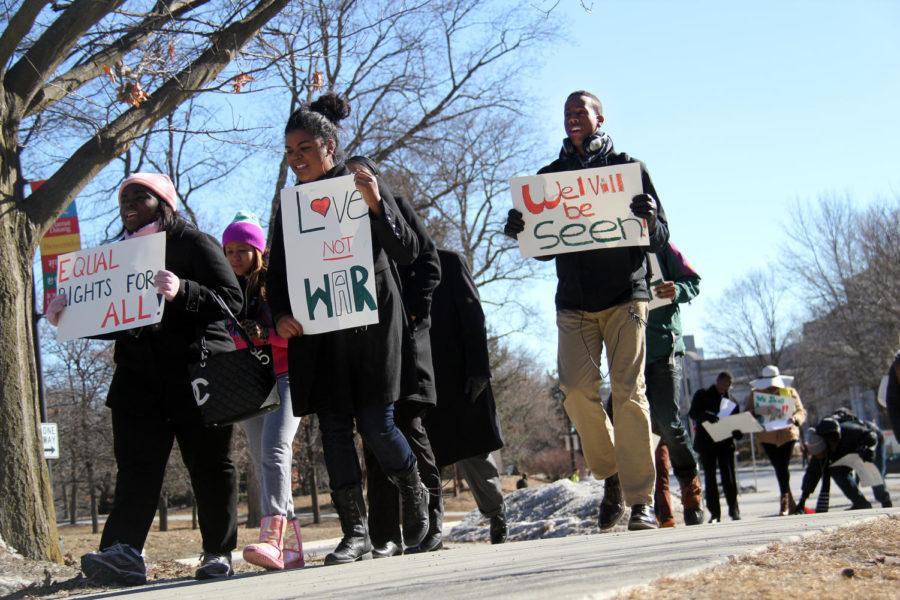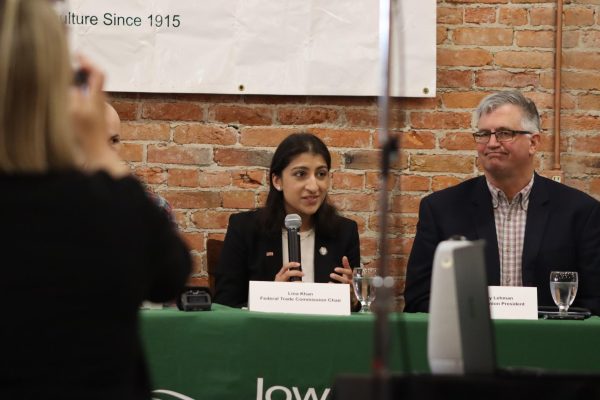- News
- News / Academics
- News / Diversity
- News / Politics And Administration
- News / Politics And Administration / Campus
Despite strides toward equality, racial disparities persist in higher education
Student members of the Black Student Alliance, marched from the Multicultural Center to the front lawn of Parks Library while carrying signs on Jan. 28, at noon. In attendance was Senior Vice President for Student Affairs Dr. Thomas Hill. The event, coordinated by Teonna Flipping, a senior in speech communication, attracted passing students around campus.
September 23, 2019
There are racial disparities in education.
From de jure segregation leading up to the Brown v. Board of Education ruling to systemic inequalities accompanying de facto segregation today, race has always played a role in the American education system. Higher education plays a crucial role in determining an individual’s expected income and, as a result, their class.
Iowa State was established in 1858, but the first black student, George Washington Carver, did not enroll at the university until 1891.
In the Iowa State community, racism continues to be present today, and experiences of racism can lower student success. Shouts of the N-word from white patrons in the Blue Owl Bar in Campustown were heard several times during the Cy-Hawk game on Sept. 14.
Selena Pintor, senior in apparel, merchandising and design, said coming to Iowa State from the east side of Des Moines was a kind of “culture shock.”
“Throughout my time […] I’ve seen a lot of different things that clearly state […] people of color are not wanted here,” Pintor said.
Pintor mentioned the white supremacist posters found at Iowa State in 2018 and chalk messages around elections, along with the white nationalist Nick Fuentes’ speech at Iowa State in March.
On what the Iowa State administration is doing to resolve the situation, Pintor said, “they could be doing more than what they are doing now.”
The Campus Climate Survey produced for Iowa State and published in April 2018 found that even 127 years after Carver’s enrollment, “Asian/Asian American, Black/African American and multiracial undergraduate student respondents all had lower perceived academic success scores than white undergraduate student respondents.”
The survey also found 24 percent of faculty and student respondents of color and 23 percent of multiracial faculty and student respondents were “very comfortable with the climate in their classes,” compared to 36 percent of white faculty and student respondents.
On campus inclusion, Pintor said, “I do [feel welcome], because I found my community, but I know I didn’t at some points — or when I see certain things I don’t always.”
In the survey, 19 percent of respondents indicated they had personally experienced “exclusionary, intimidating, offensive and/or hostile conduct,” with most of the conduct based on “ethnicity, gender/gender identity and position status.”
To ameliorate the racial disparities outcomes on campus, Iowa State tasked four implementation teams to move forward with “actionable information.”
The final report produced on undergraduate student experience noted the development of the “national conference on race and ethnicity and Iowa State conference on race and ethnicity project” were already in-progress, alongside diversity and inclusion office “campus and community initiatives.”
Antonia McGill, junior in psychology, agreed Iowa State advertises a lot of diversity, but said, “it’s all bark, no bite.”
“Being a queer woman of color as well has had its challenges and it has [made me notice] that there is a lot of issues with how the school handles certain issues,” McGill said. “Along with racism is the homophobia that we’ve dealt with as well. There was a whole issue as well on a floor last year that I was on, and we event went to [Office of Equal Opportunity] and they did nothing for us, and we went to the [Department of Residence] and they did nothing for us.”
McGill said the image the office and department gave off was that their priority was trying to “save face,” but did not want to make assumptions about what they were truly doing.
“There’s always said to be an investigation [of racist incidents], or things being done, but I feel like they never follow through,” Pintor said. “It’s just kind of like ‘oh, we’re investigating it,’ and then from there nothing is being done or nothing is being said after.”
Maryam Jernigan-Noesi, assistant professor of psychology at Agnes Scott College, said in an interview with Education Post that research demonstrates experiences of racism and racial discrimination are associated with experiences of post-traumatic stress symptoms, which can negatively affect student outcomes.
Through the 1960s, higher education continued to be segregated in the United States. Alabama Gov. George Wallace made his stand in the schoolhouse door at the University of Alabama to try to prevent its integration in 1963.
James T. Minor, senior strategist for academic success and inclusive excellence in the California State University Chancellor’s Office, examined the progress toward “desegregation of enrollments in public colleges and universities” in a 2008 article in the American Educational Research Journal.
Minor said in his article that the Morrill Land-Grant Act of 1862 authorized federal land to be used by states for the establishment of public colleges and universities. Iowa was the first state to make use of the act and it yielded increased funding for the institution that would eventually become Iowa State.
The 1890 version of the act required southern states using “race as an admission requirement to establish separate universities for persons of color; this move effectively created public [Historically Black Colleges and Universities (HBCUs)] and thus a dual system of higher education,” Minor said in his article.
Minor found over time the diversity at higher education institutions — in North Carolina at least — had declined.
“In 1984, White students at North Carolina’s public HBCUs accounted for 14.5 percent of the undergraduate population; by 2004, that percentage had dropped to 10.3 percent,” Minor said in his article. “During the same time, the percentage of Black students enrolled at [predominantly white institutions] increased by 3 percentage points from 8.2 percent in 1984 to 11.3 percent in 2004.”
HBCUs have in the meantime faced budgetary issues, with five closing since 1989.
The racial disparity in higher education follows people after they graduate, too.
A report by the think tank Demos released in June found black students make up roughly “14 percent of all students entering college, but constitute more than 27 percent of those with $50,000 in debt, and nearly 22 percent of those with over $100,000.”
Furthermore, the report said the “typical white male borrower has paid off 44 percent of his loan balance 12 years after beginning college, while the typical black female borrower has seen her balance grow by an additional 13 percent.”

















